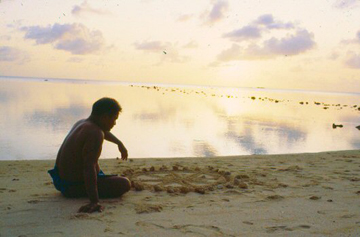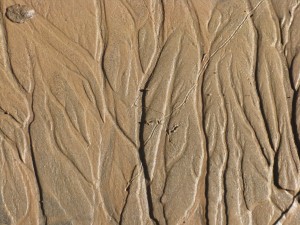Pattern Reading
Tracking
We came with vision but not with sight.
We came with visions of former places but not the sight to see where we are.
— Wendell Berry
When you are tracking and dancing, you are talking with God.
— Kalahari Bushmen
What are the movements/trends, and how do we engage with them profitably? This is the key question for business, hunting, music, health, sports, farming, design, or any human activity.Reading the patterns of the processes of life is key to a healthy, vital world. This has always been the work of the human mind.
Look at the pattern below:
The alphabet is arranged in a particular pattern here. What is it? If you were illiterate you would more easily see it. Initially, I looked for an arithmetical pattern, but that does not work. Or some form of wave… Is it Morse code? No. What is it? The letters on the upper line consist of all straight lines and those on the lower line all contain curves. Once you know, it is obvious. Why is something so obvious so difficult to see? What else are we missing? How does this impact our effectiveness? How do we learn to see patterns not things?
Tracker John Stokes says that the aim in tracking is not identification of the species, sex, age, behavior, and timing of the animal. It is to be able to see a movie in the mind’s eye of the animal making the tracks you see before you. Tracks are the visible marks left by a process that can be read to re-envision that process happening.
These letters are the tracks of my thoughts. You do not spend much attention on each letter, but read the patterns of letters as words, and the patterns of words as thoughts or ideas. You see the movement of my thoughts in your own mind by seeing through the layers of patterns of the stationary tracks.
We live in a world of tracks that we rarely read. Everything and everyone we see are tracks of processes. My house is a track of not only processes of construction, economy, culture, and climate, but also my mental and psychological processes. The hills speak of the collision of plates and erosion, while the clouds and wind tell of the movement of storms. The leaves blown into piles reveal patterns of the wind. Even the street name indicates cultural movement and power dynamics.
I realized that he was not looking at a still picture of the sky. If you took a snapshot of the clouds and asked him, ‘Mau, tell me what the weather is going to be,’ he could not give you an answer. But if you gave him a sequence of pictures on different days, he would tell you. — Nainoa Thompson





 The tracks reveal a world of movement, change, and exchange. But our vision and minds are focused on “things.” All of those “things” are tracks of processes, some longer-lasting than others. By reading through the patterns of “things” to see the processes and their trajectories, we can understand where and how to place ourselves in relation to those processes.
The tracks reveal a world of movement, change, and exchange. But our vision and minds are focused on “things.” All of those “things” are tracks of processes, some longer-lasting than others. By reading through the patterns of “things” to see the processes and their trajectories, we can understand where and how to place ourselves in relation to those processes.